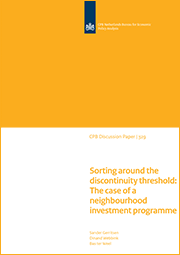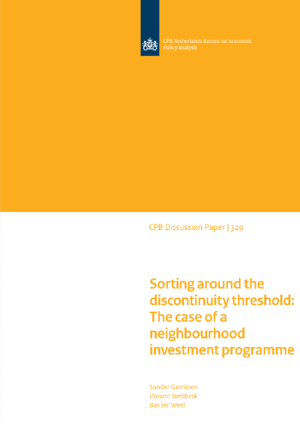Sorting around the discontinuity threshold: The case of a neighbourhood investment programme

In the period 2008-2011 the Dutch government invested 216 million Euros, while an additional amount of one billion Euros was invested by housing corporations.
Such investment programmes have been evaluated using several different econometric techniques. A popular way to estimate treatment effects is by making use of regression discontinuity (RD) designs. One of the main reasons for this is that variation around the cut-off value, which determines assignment to the treatment, can be considered as good as random. The reason for this is that those who take part in the programme have no control over the assignment. However, knowledge about the assignment rule might influence the assignment to the treatment and thereby invalidate the key assumption that individuals on either side of the discontinuity threshold are similar.
This research documents a case of sorting disadvantaged areas into the neighbourhood investment programme. Policymakers at the national level, who designed and implemented the assignment rules for the policy in disadvantaged neighbourhoods, sorted areas into and out of the programme in such a way that there exists a large discontinuity in the share of non-Western immigrants at the discontinuity threshold. At the threshold value for the assignment to the treatment we find a large and statistically significant gap in the proportion of non-Western immigrants of between 11 and 21 percentage points. Moreover, there exists non-compliance with a bias toward removing areas with lower shares of non-Western immigrants from the treatment group.
The violation of a continuous distribution around the discontinuity threshold of this important characteristic could be due to the way the selection process of neighbourhoods has been carried out. Politicians at the national level demanded that there had to be a list of 40 eligible neighbourhoods. To determine the 40 neighbourhoods, a two-step procedure has been used. In the first step, a preliminary list of 40 neighbourhoods was created based on the most disadvantaged postal code areas (PCAs) according to the ‘quality’ index. Because most neighbourhoods consist of multiple adjacent PCAs, policymakers sometimes merged PCAs with different rank numbers to create a neighbourhood. This opens possibilities of adding lower-ranked PCAs to an already identified neighbourhood. When we move down the list of PCAs, it is possible to add more PCAs beyond the point at which 40 geographical areas have been identified as neighbourhoods. This process continues until a PCA from a different geographical area is next on the list and would become neighbourhood number 41. We show that neighbourhood 41 is indeed in another city. In the second step, a number of PCAs were removed from and added to this list to obtain a final list of 40 eligible neighbourhoods. We show that the added neighbourhoods are not close to the discontinuity threshold.
We illustrate the bias of the RD estimates when using the official cut-off. We find that the estimates from RD models that do not take account of the endogenous sorting differ from the estimates from RD models that do account for the endogenous sorting. We also show that a different selection process of 40 neighbourhoods does not lead to a discontinuity in the share of non-Western immigrants. Finally, we cannot rule out that the result of selecting 40 neighbourhoods in this way is a coincidence. Using the same procedure to select 30 neighbourhoods does not yield the same discontinuities.
